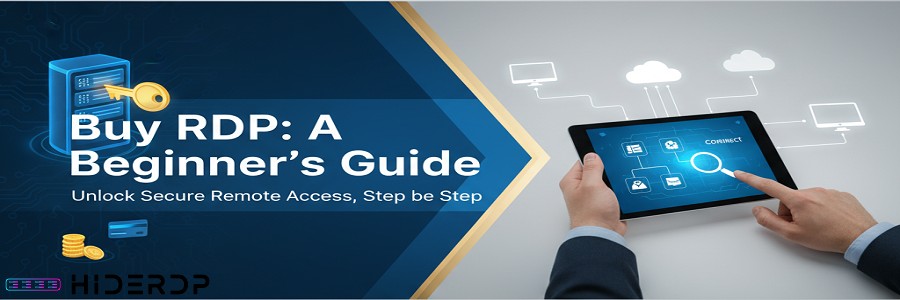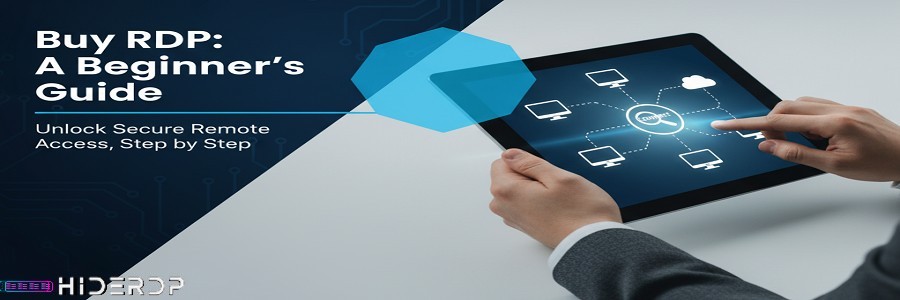Remote Desktop Protocol (RDP) has become an indispensable tool for individuals and businesses seeking efficient and secure remote access to computers.
Whether you’re a freelancer managing projects on the go, a small business needing to provide employees with remote work capabilities, or a developer requiring a stable environment for testing, understanding how to buy RDP is the first step towards unlocking a world of remote possibilities.
This guide is designed to demystify the process for beginners, ensuring you make an informed decision.
At its core, RDP allows you to connect to a remote computer and interact with its desktop environment as if you were sitting right in front of it. This means you can run applications, access files, and perform tasks from virtually anywhere, using your local device as a window to the remote machine.
The benefits are immense: increased flexibility, enhanced collaboration, and the ability to leverage powerful hardware without the need for physical presence.
Buy RDP: A Beginner’s Guide Free
For those just starting out, the concept of a “free” RDP might seem appealing. While there are some limited-time trials or very basic RDP services available at no cost, it’s crucial to understand that a robust, reliable, and secure RDP service typically comes with a price tag.
These free options often have severe limitations in terms of speed, uptime, security, and resource allocation, making them unsuitable for any serious use. Our focus here is on helping you understand how to buy RDP: a beginner’s guide free from common pitfalls, rather than promoting unsustainable free services.
When considering a paid RDP service, you’re investing in dedicated resources, professional support, and advanced security features that ensure your remote work is seamless and protected. This investment pays off in reliability and peace of mind.
Buy RDP: A Beginner’s Guide Free from Common Mistakes
To truly benefit from this guide, let’s help you buy RDP: a beginner’s guide free from common pitfalls:
- Don’t automatically go for the cheapest option: While cost is a factor, extremely cheap RDP often means compromised quality, shared resources, and poor support.
- Don’t skip security considerations: Always use strong, unique passwords for your RDP. If your provider offers two-factor authentication, enable it.
- Don’t ignore the server location: High latency due to a distant server can ruin the remote experience.
- Don’t forget to back up your data: Even with reliable RDP, data loss can occur. Regularly back up important files.
- Don’t hesitate to ask for support: If you encounter issues, reach out to your provider’s customer support.

Key Factors to Consider When You Buy RDP
Before you finalize your decision to buy RDP, it’s important to evaluate several key factors to ensure the service meets your specific needs:
- Operating System (OS): Most RDP services offer Windows-based operating systems (e.g., Windows Server 2012, 2016, 2019, or Windows 10/11 for specific use cases). Linux-based RDP is also available but might require different client software or a different remote desktop solution (like VNC).
- Resources (RAM, CPU, Storage): These are critical for the performance of your remote desktop.
- RAM: More RAM means you can run more applications simultaneously without slowdowns.
- CPU: A powerful CPU (measured in cores and clock speed) ensures applications run smoothly.
- Storage: The type (HDD vs. SSD) and amount of storage determine how fast files load and how much data you can store. SSDs are significantly faster and recommended for most uses.
- Bandwidth: This dictates the speed of your internet connection to and from the RDP server. High bandwidth is crucial for smooth streaming, fast file transfers, and responsive remote control.
- Location: The physical location of the RDP server can affect latency. Choosing a server closer to your geographical location or that of your target audience will generally result in a faster and more responsive experience.
- Security Features: Look for providers that offer robust security, including firewalls, DDoS protection, regular backups, and secure data centers.
- Customer Support: Reliable technical support is invaluable, especially for beginners. Ensure the provider offers multiple channels for support (chat, email, phone) and has a good reputation for responsiveness.
- Pricing and Plans: Compare different providers’ pricing models. Some offer hourly billing, while others have monthly or annual subscriptions. Understand what’s included in each plan to avoid hidden costs.
How to Buy RDP: A Step-by-Step Approach
Once you’ve considered the factors above, the process to buy RDP generally involves these steps:
- Identify Your Needs: Determine what you’ll use the RDP for. Is it for basic browsing, heavy software, multiple users, or a specific application? This will help you define the required resources.
- Research Providers: Look for reputable RDP providers. Read reviews, check their website for features, pricing, and support.
- Choose a Plan: Select an RDP plan that aligns with your resource requirements and budget.
- Complete the Purchase: Follow the provider’s instructions to complete the payment.
- Receive RDP Details: After purchase, you’ll typically receive an email with your RDP credentials, including the IP address, username, and password.
- Connect to Your RDP:
- Windows: Use the built-in “Remote Desktop Connection” client.
- macOS: Download the Microsoft Remote Desktop app from the App Store.
- Linux/Mobile: Various third-party RDP clients are available.
- Enter the IP address, username, and password provided by your host.
Conclusion
Learning how to buy RDP is an empowering step towards greater flexibility and efficiency in your digital life. By understanding your needs, carefully researching providers, and considering key factors like resources, security, and location, even beginners can successfully acquire and utilize an RDP service.
Remember, investing in a quality RDP solution will save you time and frustration in the long run, providing a stable and secure platform for all your remote computing needs.

